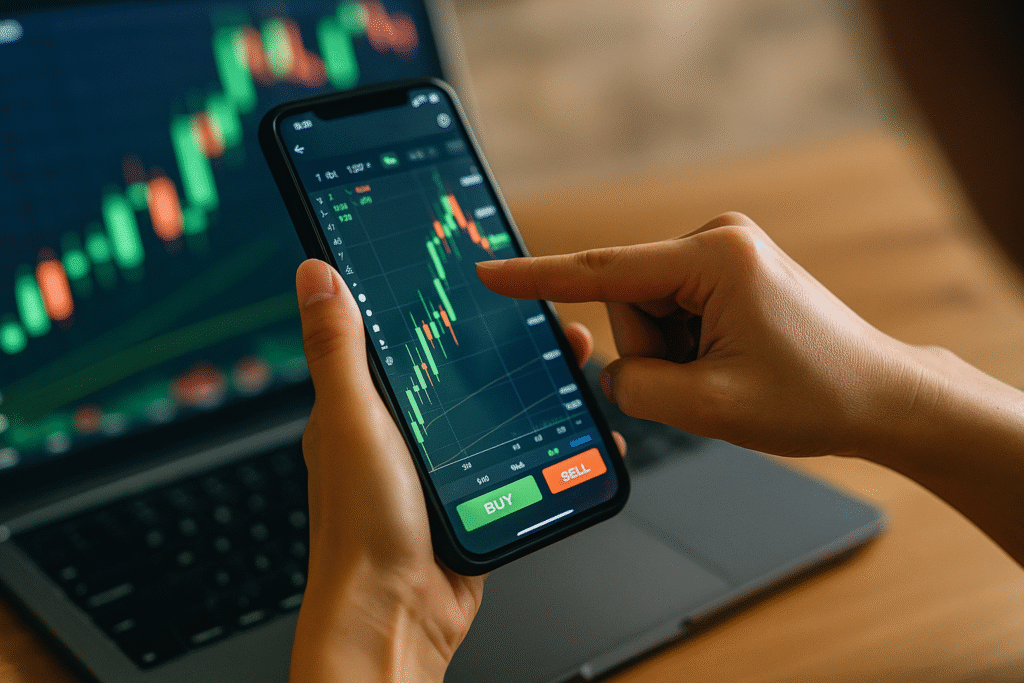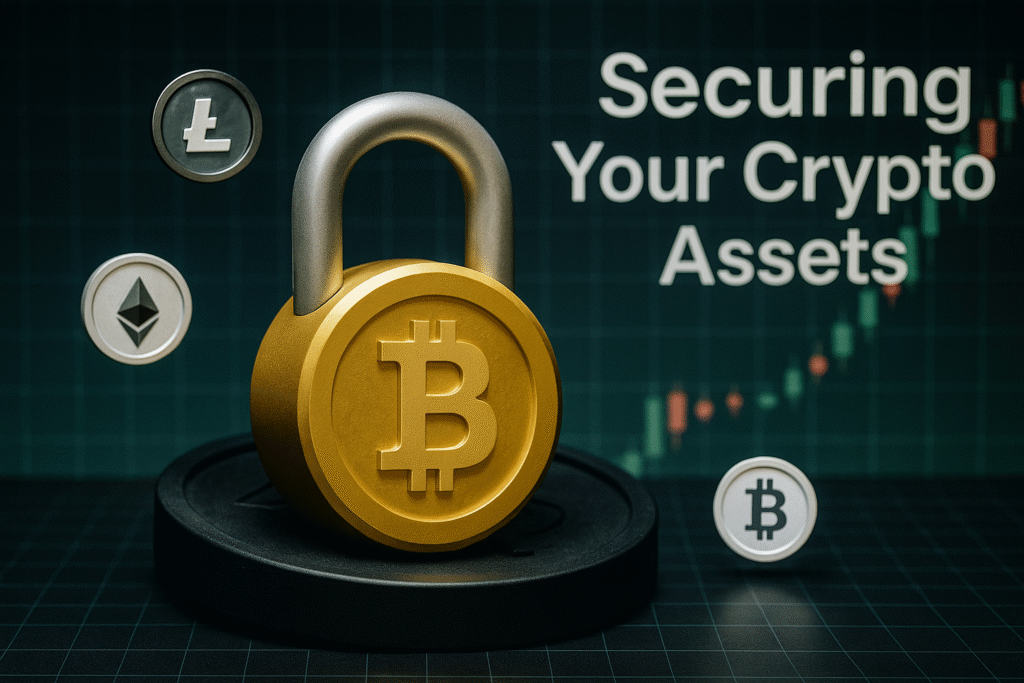If you’re just stepping into the world of digital assets, understanding how to navigate a crypto exchange guide is essential. Think of it as your on-ramp to the blockchain highway—no detours, no jargon overload. This cryptocurrency trading basics breakdown will demystify platforms like Coinbase, Binance, and Kraken, helping you move from confused to confident with every click.
I remember my first time trying to buy Bitcoin. Three browser tabs open, two YouTube tutorials playing, and still zero clue what a “limit order” meant.
This guide will walk you through navigating crypto exchanges without the technical jargon or the expensive mistakes most beginners make.
From choosing the right exchange for your needs to executing your first trade with confidence, you’ll get everything laid out in plain English. No computer science degree required.
But before we dive into the step-by-step process, there’s one critical mistake nearly every new trader makes that costs them money instantly…
Understanding Cryptocurrency Basics

Why Crypto Matters in Today’s Financial Landscape
The traditional banking system has served us for centuries, but it’s showing its age. Meanwhile, decentralized finance isn’t just some passing fad—it’s revolutionizing how money works.
Think about sending money internationally. With banks, you’ll wait days and pay hefty fees. With crypto? Minutes and pennies. That’s a game-changer for millions of people—and one of the key advantages highlighted in any solid crypto exchange guide.
Crypto also gives financial access to the 1.7 billion adults worldwide without bank accounts. All you need is a smartphone and internet connection to join the global economy.
And let’s talk about control. Your bank can freeze your account, charge whatever fees they want, and make decisions without your input. With crypto, you’re in charge of your own money – no middlemen, no permission needed.
During economic uncertainty (hello, inflation!), crypto assets like Bitcoin have increasingly emerged as potential hedges. Some even call Bitcoin “digital gold” because of its limited supply.
Companies are catching on too. Tesla, Microsoft, and PayPal now accept crypto payments. Major investment firms are adding Bitcoin to their portfolios. Even countries like El Salvador have adopted Bitcoin as legal tender.
Key Terminology Every Beginner Should Know
Jumping into crypto without knowing the lingo is like walking into a foreign country without a translation app. Here’s what you absolutely need to know:
Blockchain: The digital ledger that records all transactions. Think of it as a chain of blocks, each containing transaction data that can’t be altered once added.
Wallet: Where you store your crypto. Not an actual wallet, but software that holds your private keys (like passwords) to access your funds.
Mining: The process of validating transactions and adding them to the blockchain. Miners solve complex puzzles and get rewarded with new coins.
DeFi: Short for Decentralized Finance – financial services without banks. Lending, borrowing, and trading directly between people.
Smart Contracts: Self-executing contracts with the terms written into code. They automatically run when conditions are met – no lawyers needed.
Gas Fees: The cost of doing transactions on networks like Ethereum. Think of it as the toll you pay to use the blockchain highway.
HODL: Crypto slang for holding onto your coins long-term instead of selling, originally from a typo of “hold.”
Staking: Staking digital assets means locking up your crypto to support network operations and earning rewards in return. Essentially, it’s like earning interest—but for crypto.
Different Types of Cryptocurrencies Worth Exploring
The crypto world is way bigger than just Bitcoin. A good crypto exchange guide will walk you through a breakdown of the major players:
Bitcoin (BTC): The OG crypto. Created in 2009, it’s digital gold – a store of value with a capped supply of 21 million coins.
Ethereum (ETH): More than just money, Ethereum is a platform for building applications. It introduced smart contracts to the world.
Stablecoins (USDC, USDT, DAI): These maintain a steady value, usually pegged to the US dollar. Perfect for those who want crypto benefits without the rollercoaster price movements.
Altcoins: Basically any cryptocurrency that’s not Bitcoin. Some notable ones:
- Solana: Super fast transactions and low fees
- Cardano: Focused on sustainability and research-driven development
- Polkadot: Connects different blockchains together
Memecoins: Started as jokes but gained real value. Dogecoin and Shiba Inu fall here. High risk, but sometimes high reward.
Privacy Coins: Monero and Zcash focus on keeping transactions anonymous. Regular crypto is actually more traceable than cash!
Utility Tokens: Coins with specific purposes within platforms. Like buying FIL to pay for storage on Filecoin’s network.
The Technology Behind Crypto: Blockchain Explained Simply
Blockchain sounds complex, but fundamentally, the core idea is pretty straightforward: it’s a special kind of distributed ledger that’s nearly impossible to cheat.
Imagine a shared Google Doc that anyone can view, but once something’s typed in, it can’t be erased or changed. That’s basically blockchain.
When you make a transaction, it gets bundled with others into a “block.” This block is verified by thousands of computers around the world (called nodes). Once verified, it’s linked to previous blocks, creating a “chain” of blocks – hence, blockchain.
The magic happens through consensus mechanisms. The two main types are:
Proof of Work: Computers compete to solve math problems. Bitcoin uses this, but it requires tons of energy.
Proof of Stake: Validators put up their own crypto as collateral to verify transactions. Much more energy-efficient.
What makes blockchain revolutionary is that it’s:
- Decentralized: No single person or company controls it
- Transparent: Anyone can view all transactions
- Immutable: Once recorded, data can’t be changed
- Secure: It would take impossible amounts of computing power to hack
This technology goes way beyond money. It’s being used for supply chain tracking, voting systems, medical records, and countless other applications where trust and transparency matter.
Choosing the Right Crypto Exchange for Your Needs

A. Top-Rated Exchanges for Beginners in 2025
The digital trading hub landscape has shifted dramatically this year. Notably, for newbies diving into the crypto pool, these platforms stand out from the pack:
Coinbase – Still the gold standard for beginners in 2025. Their revamped interface makes buying your first Bitcoin almost too easy. Their “Learn to Earn” program now offers up to $200 in free crypto just for watching videos.
Binance Lite – They finally listened to feedback and created a truly beginner-friendly version. The simplified dashboard removes the intimidation factor completely.
Kraken Starter – The new kid on the block specifically designed for first-timers. Their “Training Wheels Mode” lets you practice with fake money before committing real cash.
Gemini – The Winklevoss twins’ platform remains rock-solid with the best customer service in the game. Their phone support is available 24/7 now, a game-changer when you’re panicking at 2 AM.
eToro – The social trading aspect makes this perfect for beginners who want to copy successful traders. In 2025, they’ve added AI-powered suggestions that actually make sense.
Remember, the “best” exchange varies based on where you live, what you want to trade, and your comfort with technology. Any reliable crypto exchange guide will emphasize that most beginners end up using 2–3 different exchanges as they grow more confident.
B. Security Features to Look For
Crypto security isn’t optional – it’s everything. When shopping for an exchange, these features should be non-negotiable:
Two-factor authentication (2FA): Basic protection, but make sure they support app-based 2FA, not just SMS (which can be hacked).
Cold storage policies: Top-tier exchanges keep 95%+ of funds in offline “cold” storage, safe from online hackers.
Insurance coverage: The best platforms now insure your holdings against breaches. Gemini and Coinbase lead here with full insurance on digital assets.
Regulatory compliance: In 2025, legitimate exchanges are registered with financial authorities. Fly-by-night operations aren’t worth the risk, no matter how good the deals seem.
Withdrawal protections: Look for time delays, verification requirements, and email confirmations for withdrawals.
Transparent security audits: Can they prove their security with regular third-party audits? If not, why?
Biometric authentication: Fingerprint and facial recognition add an extra layer that’s tough to crack.
Don’t just assume an exchange is secure because it’s popular. Even the biggest names have been hacked. The difference is how they respond and whether they make customers whole afterward.
C. Fee Structures and How They Impact Your Profits
Fees eat profits faster than you’d think. Surprisingly, a 1% difference in transaction costs might seem small—until you do the math on larger trades.
Most exchanges use these fee types:
| Fee Type | What It Is | Impact on Profits |
|---|---|---|
| Trading Fees | Percentage charged per trade | Directly reduces each trade’s profit margin |
| Deposit Fees | Cost to add money to your account | Front-loads your investment cost |
| Withdrawal Fees | Cost to move crypto off exchange | Reduces final value when cashing out |
| Conversion Fees | Hidden in the exchange rate | Often overlooked but can exceed trading fees |
| Inactivity Fees | Charged if account dormant | Slowly drains inactive accounts |
Trading fees typically range from 0.1% to 1.5% in 2025. That might seem minimal, but for active traders, it adds up fast. A trader making $10,000 in trades monthly pays $1,200 yearly with a 1% fee versus $120 with a 0.1% fee.
Watch for tiered fee structures too. Many exchanges reward higher volume with lower fees. A well-crafted crypto exchange guide will show how, if you’re planning to trade regularly, these tiers can significantly boost your bottom line.
The sneakiest fees are spread markups – the difference between the buying and selling price. Some “no-fee” exchanges make their money here, charging up to 2% in the spread. Always check both the listed fee and the actual execution price.
D. User Interface Considerations
The difference between a good and bad crypto exchange experience often comes down to the interface. Specifically, beginners need a user-friendly platform that doesn’t require a computer science degree to navigate.
When evaluating interfaces, ask yourself:
Can I find basic functions easily? Buying, selling, and checking your portfolio should take seconds, not minutes of hunting.
Is the mobile app full-featured? In 2025, most trading happens on phones. A hampered mobile experience is a deal-breaker.
How are charts presented? Simple candlestick charts with customizable time frames help even novices spot trends.
Is there a demo mode? The ability to practice without real money is invaluable for beginners.
Night mode options? Your eyes will thank you during those late-night trading sessions.
Load times? Slow interfaces can cost real money when prices are moving fast.
The best interfaces grow with you. They offer a “basic view” for beginners but let you access advanced features as your confidence grows.
Pay attention to accessibility too. Good platforms support screen readers, offer keyboard shortcuts, and maintain sufficient color contrast. These features help everyone, not just users with disabilities.
E. Supported Currencies and Trading Pairs
The crypto universe has expanded far beyond Bitcoin. In 2025, serious exchanges support hundreds of currencies, but that doesn’t mean more is always better.
Quality matters more than quantity. A trustworthy crypto exchange guide will recommend looking for platforms that carefully vet new coins rather than listing everything under the sun.
For beginners, ensure the exchange supports these essentials:
- Major cryptocurrencies (Bitcoin, Ethereum, Solana)
- Established altcoins (Cardano, Polkadot, Avalanche)
- Stablecoins (USDC, USDT, DAI)
- At least one meme coin (if that’s your thing)
Trading pairs matter too. A “pair” is just two currencies you can trade directly between. Additionally, more exchangeable asset combos mean more flexibility.
Direct fiat pairs are crucial for beginners – the ability to buy crypto directly with USD, EUR, etc. without first buying Bitcoin. This saves on conversion fees and simplifies the process.
Watch for liquidity in the pairs you care about. Low-liquidity pairs have wider spreads and more price slippage, silently eating into profits.
Some exchanges now offer “fractional staking pairs” – a 2025 innovation that lets you trade and earn staking rewards simultaneously. If passive income interests you, these specialized pairs are worth considering.
Setting Up Your First Exchange Account

Creating a Secure Profile
So, you’ve decided to dive into the crypto world? Great! Your first step is setting up a bulletproof exchange account. When creating your profile, don’t rush through it. Use a unique email address dedicated to your crypto activities – it makes tracking and security much simpler.
For your password, forget about your pet’s name or birthday. Go for something complex: mix uppercase and lowercase letters, throw in some numbers and symbols. Aim for at least 12 characters. And please, don’t reuse passwords from other sites – that’s like using the same key for your house, car, and office.
Many exchanges will ask for basic personal info. Be accurate here. Typos or mismatched information can cause headaches later when you’re trying to withdraw your funds or verify your identity.
Completing KYC Requirements Efficiently
KYC (Know Your Customer) might seem like a pain, but it’s essentially protecting you and the marketplace. Most exchanges require identity verification steps such as:
- Government-issued ID (passport, driver’s license)
- Proof of address (utility bill, bank statement)
- A selfie holding your ID or a verification code
Pro tip: Have these documents ready in digital format before you start. Make sure they’re clear, current (usually within 3 months for bills), and match the name on your profile exactly. Most crypto exchange guide checklists highlight this as a key step in smooth onboarding.
Setting Up Two-Factor Authentication
This isn’t optional, folks. 2FA adds a critical second layer of security that can save your crypto from being swiped.
Most exchanges offer several 2FA options:
- SMS verification (decent, but not the best)
- Email codes (better than nothing)
- Authenticator apps like Google Authenticator or Authy (your best bet)
- Hardware keys like YubiKey (the gold standard)
Whatever you do, don’t skip this step. And store your backup codes somewhere safe – maybe even print them and keep them in a locked drawer.
Connecting Payment Methods Safely
Time to fund your account. Most exchanges let you connect:
- Bank accounts (slower but usually lower fees)
- Credit/debit cards (faster but higher fees)
- Other payment services
Start small with your first deposit – just to test the waters. Make sure you’re on the legitimate exchange website (check that URL carefully) before entering any financial information.
Consider using a dedicated bank account or card for crypto trading. This keeps your crypto finances separate and makes tracking easier come tax season.
Remember that each payment method has different processing times and fees. Bank transfers might take days but save you money, while card payments are nearly instant but costlier.
Making Your First Cryptocurrency Purchase

Funding Your Exchange Account
Ready to buy your first crypto? You’ll need to get some money onto the exchange first. Most platforms offer several options for funding your account before purchasing your first digital asset:
- Bank Transfer (ACH) – Free but takes 3-5 business days
- Wire Transfer – Same-day but costs $10-30
- Debit/Credit Card – Instant but expect fees around 3-5%
- PayPal/Digital Wallets – Quick but not available on all exchanges
Pro tip: Bank transfers might be slower, but they’re usually free. Card purchases are convenient but those fees add up fast—especially on larger buys.
Each exchange has different minimums too. Some let you start with just $5, while others require $50 or more. Check this before you choose your platform if you’re planning to start small.
Executing Market vs. Limit Orders
The two main ways to buy crypto are market orders and limit orders. Here’s the real difference:
Market Orders are the “I want it now” option. You’re saying “give me X amount of Bitcoin at whatever the current price is.” Simple and instant, but you might pay slightly more than expected during volatile periods.
Limit Orders let you set the price you’re willing to pay. Like saying, “I’ll buy Bitcoin, but only when it hits $30,000.” Your order sits there until the price reaches your target (or you cancel it). A smart crypto exchange guide will explain how limit orders like this give you more control—and can save you money.
| Order Type | Pros | Cons |
|------------|----------------------------|---------------------------------|
| Market | • Instant execution | • No price control |
| | • Guaranteed to complete | • Potential price slippage |
| Limit | • Control your price | • Might never execute |
| | • Potentially better deal | • Requires market knowledge |
Beginners usually start with market orders. They’re straightforward—just type how much you want to buy and hit submit.
Understanding Trading Pairs and Exchange Rates
Crypto markets work in digital trading pairs, which can be confusing initially. You’re not just buying Bitcoin—you’re trading one asset for another.
The most common trading pairs are:
- Crypto/USD pairs (BTC/USD, ETH/USD): You’re using dollars to buy crypto
- Crypto/Crypto pairs (BTC/ETH, ETH/SOL): You’re trading one crypto for another
- Stablecoin pairs (BTC/USDT, ETH/USDC): You’re using dollar-pegged tokens
The exchange rate shows how much of one asset you need to get the other. For example, if BTC/USD is $35,000, that’s how many dollars you need for one Bitcoin.
What trips up newcomers is that prices fluctuate constantly. The rate you see when browsing might not be the exact rate you get when buying 30 seconds later.
Some exchanges also display prices differently—either per whole coin or per smaller unit. Don’t panic if Bitcoin shows as $35,000 on one exchange and $35,100 on another. Price differences between exchanges are normal.
Common First-Time Buyer Mistakes to Avoid
I’ve seen these mistakes hundreds of times from new crypto buyers:
Ignoring fees completely. Exchange fees range from 0.1% to 5% depending on the platform and payment method. These can seriously eat into your investment. Always check the fee schedule before buying.
Buying a coin just because it’s “cheap.” A $0.001 tokenized asset isn’t necessarily better value than a $30,000 Bitcoin. Ultimately, what matters is the potential percentage growth, not the per-token price.
Going all-in immediately. The crypto market is volatile. A savvy crypto exchange guide will often recommend dollar-cost averaging—buying small amounts at regular intervals—rather than dumping your entire budget at once. It’s a steady strategy for a bumpy ride.
Forgetting security basics. Enable two-factor authentication (2FA) before making your first purchase. And please, write down your password and recovery phrases somewhere secure.
Not understanding tax implications. In most countries, crypto purchases and sales are taxable events. Keep records of all transactions from day one—your future self will thank you when tax season arrives.
Securing Your Crypto Assets

Hot vs. Cold Wallet Storage Options
You’ve bought some crypto and now you’re wondering where to keep it. This is literally the most important decision you’ll make after entering the market.
Hot wallets are connected to the internet – think mobile apps or exchange accounts. They’re super convenient when you need to make quick trades or payments. But here’s the catch – they’re also more vulnerable to hacks and phishing attacks. It’s like keeping cash in your pocket versus a safe.
Cold wallets, on the other hand, stay completely offline. Hardware wallets like Ledger or Trezor are physical devices that look like USB sticks. Paper wallets are exactly what they sound like – private keys printed on actual paper. They’re practically immune to online attacks, but they can be lost, damaged, or stolen physically.
Here’s a quick breakdown:
| Wallet Type | Pros | Cons | Best For |
|---|---|---|---|
| Hot Wallet | Easy access, user-friendly | Higher security risk | Small amounts, frequent trading |
| Cold Wallet | Maximum security | Less convenient, potential physical loss | Long-term holdings, large amounts |
Most crypto veterans follow a simple rule: hot wallets for spending money, cold wallets for savings accounts. Learn more about the difference here.
Best Practices for Private Key Management
Your private keys are the master password to your crypto kingdom. Lose them, and you can kiss your crypto goodbye. Any comprehensive crypto exchange guide will stress this: security isn’t optional—it’s everything.
First rule: NEVER share your wallet recovery phrase or private keys with anyone. Crucially, not customer support, not your crypto buddy, not even your mom. No legitimate service will ever ask for them.
Store your seed phrase (those 12-24 words) in multiple physical locations. Write them down on paper or stamp them into metal plates for fire resistance. Don’t store them digitally where they could be hacked – not in cloud storage, not in a photo, not in a password manager.
Consider using a passphrase on top of your seed phrase for hardware wallets. It’s like adding a second lock to your front door.
For extra paranoia points (which are good points to have in crypto), consider multisignature wallets that require multiple keys to authorize transactions – like needing two keys to launch a nuclear missile.
Backup Strategies to Prevent Loss
The crypto world is littered with horror stories of lost millions. Don’t be that person.
Create redundant backups of your wallet information. One backup isn’t enough – what if there’s a fire or flood? Keep copies in different physical locations.
For hardware wallets, test your recovery process before putting significant funds in. Seriously – wipe your device and restore it from your seed phrase to make sure everything works.
Consider splitting your holdings across multiple wallets. Don’t keep all your crypto eggs in one basket.
Some people use the 3-2-1 backup strategy:
- 3 total copies of your seed phrase
- 2 different physical locations (minimum)
- 1 copy in a bank deposit box or other secure location
For inheritance planning (yeah, not fun to think about but necessary), consider creating a “crypto will” with instructions for loved ones on how to access your digital asset access if something happens to you. Importantly, don’t include the actual private keys in your will—that becomes public record!
Remember, in crypto you are your own bank. That’s incredibly empowering, but it also means you’re the security guard, the vault designer, and the insurance policy all rolled into one. A thorough crypto exchange guide drives this point home: self-custody demands self-responsibility.
Navigating Advanced Exchange Features

Understanding Order Books and Depth Charts
The beating heart of any crypto exchange is the order book. Think of it as a live snapshot of who’s buying, who’s selling, and at what prices. Learn more about order books here.
When you first look at an order book, it might seem like a jumbled mess of numbers. On one side, you’ve got buy orders (bids) – people waiting to purchase crypto at specific prices. On the other, sell orders (asks) – folks looking to cash out.
The gap between the highest bid and lowest ask? That’s called the spread. Tighter spreads usually mean more active trading.
Depth charts visualize this same information but in a way that’s easier to grasp visually. They show the cumulative volume of orders at different price points. The steeper the curve, the more resistance there is to price movement in that direction.
Pro tip: Large “walls” in a depth chart often indicate key support or resistance levels where big players have placed significant orders. When these walls disappear suddenly, price can move fast – really fast.
Using Stop Losses to Protect Your Investment
Let’s talk about the safety net every crypto trader needs: stop losses.
A stop loss is an automatic order that triggers when prices hit a certain threshold. In essence, it’s like having a robot watching your crypto holdings 24/7, ready to pull the ejection handle if things go south.
Here’s how they work in practice:
- You buy Bitcoin at $40,000
- You set a stop loss at $38,000 (5% below your entry)
- If Bitcoin drops to $38,000, your position automatically sells
Why this matters: Crypto markets move at warp speed. A coin can drop 20% while you’re sleeping. Stop losses help you define your risk before you even enter a trade.
But be careful with setting stops too tight. In volatile markets, temporary price swings might trigger your stop before the asset resumes its upward trend. Finding that sweet spot takes practice.
Exploring Margin Trading Cautiously
Margin trading is like borrowing the exchange’s money to make bigger bets. Sound exciting? It is – but it’s also how newcomers can get absolutely wrecked.
When you trade on margin, you’re using leverage—essentially amplifying both potential gains and losses. A 5x leverage means a 10% price move could result in either a 50% profit or a 50% loss. A solid crypto exchange guide will caution beginners: leverage is powerful, but it’s not a toy.
Most exchanges offer leverage ranging from 2x to 100x (yes, that’s not a typo). Higher leverage means higher liquidation risk – the point where the exchange forcibly closes your position to prevent further losses.
The golden rule? Start small. Really small. Try 2x leverage until you understand exactly how it works. And never, ever use more than you can afford to lose.
Remember that funding rates (fees paid between longs and shorts) can eat into profits during extended trades. Always factor these into your strategy.
Staking and Earning Interest on Your Holdings
Why let your digital currency sit idle when it could be working for you? Meanwhile, many exchanges now offer staking—essentially the crypto equivalent of a savings account.
Staking works differently depending on the cryptocurrency:
- For Proof-of-Stake coins like Ethereum, you’re helping secure the network
- For others, you’re providing liquidity to trading pools
- Some exchanges simply offer interest on deposits
Annual yields typically range from 3% to 20% depending on the asset and platform. The catch? Your funds are usually locked for a certain period, and there may be “unbonding” time when you decide to withdraw.
Most exchanges make staking dead simple – just a toggle switch in your account. But the real value comes from compounding: reinvesting your staking rewards to generate even more returns over time.
One final thing to consider: tax implications. In many jurisdictions, staking rewards count as income. A responsible crypto exchange guide will remind you to keep clean records—your future self (and your accountant) will thank you.
Building a Sustainable Trading Strategy

Setting Clear Financial Goals
Look, jumping into crypto without a game plan is like hopping on a rollercoaster blindfolded. Not smart.
First, ask yourself: what’s your endgame here? Are you saving for something big down the road? Building a retirement nest egg? Or just trying to make some quick cash?
Your goals dictate everything else. If you’re playing the long game, you’ll make completely different moves than someone looking for next-week profits.
Break it down into timeframes:
- Short-term: 3-12 months
- Mid-term: 1-5 years
- Long-term: 5+ years
The digital asset market doesn’t care about your dreams—it’ll swing wildly regardless. Therefore, your job is setting realistic targets that won’t have you panic-selling during the inevitable dips.
Pro tip: Write your goals down. Seriously. Put actual numbers on paper: “I want to grow my portfolio by 25% this year” or “I’m allocating 5% of my savings to crypto.” Having concrete numbers keeps you honest.
Diversification Techniques for Beginners
Crypto newbies often make the same mistake: going all-in on one coin because some YouTuber promised “100x gains guaranteed!”
Here’s the truth – nobody knows which coins will explode next. Nobody.
Smart diversification looks like:
- Mix established cryptocurrencies (Bitcoin, Ethereum) with smaller, promising projects
- Spread investments across different crypto categories:
- Store of value (Bitcoin)
- Smart contract platforms (Ethereum, Solana)
- DeFi tokens (Uniswap, Aave)
- NFT/Metaverse projects
Think of it as building a crypto portfolio, not just collecting random coins. The ratio depends on your risk tolerance, but a good crypto exchange guide suggests beginners keep at least 50–60% in established cryptocurrencies.
Don’t diversify just for the sake of it either. Having positions in 50 different tokens doesn’t make you safer – it makes you scattered. Choose quality over quantity.
Dollar-Cost Averaging vs. Lump Sum Investing
Timing the crypto market perfectly is nearly impossible. Even the experts get it wrong constantly.
Dollar-cost averaging (DCA) is your friend here. Instead of dropping $1,000 at once, you invest $100 weekly for 10 weeks. This crypto investing strategy has two major benefits: first, it helps smooth out volatility by spreading your buys across market highs and lows.
- It reduces the impact of volatility
- It removes the emotional pressure of timing the market
Here’s how the approaches stack up:
| Strategy | Pros | Cons |
|---|---|---|
| DCA | Less stress, works well in volatile markets, disciplined approach | May underperform in steadily rising markets |
| Lump Sum | Better returns in bull markets, simplicity | Higher risk if market drops right after investing |
The data shows lump sum investing slightly outperforms DCA in most traditional markets over the long term. But crypto isn’t a traditional market—its extreme volatility makes DCA particularly valuable for beginners. A smart crypto exchange guide breaks this down so you can choose a strategy that fits both your risk profile and the wild ride ahead.
Tax Implications of Crypto Trading
The tax man always gets his cut – even in crypto. This catches so many traders off guard.
In most countries, each crypto trade is a taxable event. That means:
- Selling crypto for fiat (USD, EUR, etc.)
- Trading one crypto for another
- Using crypto to buy goods or services
All potentially trigger tax obligations. Yep, even swapping Bitcoin for Ethereum counts.
Tax treatment varies by country, but generally:
- Short-term trades (assets held <1 year) face higher tax rates
- Long-term holdings often qualify for reduced rates
- Losses can sometimes offset gains
Don’t be the person scrambling at tax time with thousands of untracked blockchain asset transactions. Ideally, use dedicated crypto tax software from day one. Your future self will thank you.
Tools for Tracking Performance
Flying blind with your crypto investments? Recipe for disaster.
A good tracking system helps you understand what’s working, what isn’t, and keeps you accountable to your goals. Here are essential tools for your arsenal:
Portfolio trackers: CoinMarketCap, CoinGecko, or Koinly let you monitor your holdings across exchanges
Tax calculation software: CoinTracker, CoinLedger, or TaxBit automatically generate tax reports
Trading journals: Keep notes on why you made specific trades and what you learned
Performance metrics to track:
- Total return (%)
- Return vs. Bitcoin/Ethereum
- Volatility of your portfolio
- Maximum drawdown (largest drop from peak to trough)
The most important tracking habit? Regular portfolio reviews. Set a calendar reminder for monthly check-ins. A detailed crypto exchange guide will emphasize comparing your performance against your goals—and making adjustments as needed to stay on track.
These tools aren’t just for convenience – they transform emotional trading decisions into data-driven ones.
Conclusion

Navigating Your Crypto Journey
Stepping into the world of digital currency platforms doesn’t have to be intimidating. By understanding the fundamentals of cryptocurrencies, carefully selecting an exchange that aligns with your needs, and properly securing your digital assets, you’re well on your way to becoming a confident crypto trader. Ultimately, remember that making your first purchase is just the beginning—as you grow more comfortable, you can explore advanced exchange features and develop trading strategies that match your financial goals.
Your crypto journey is a marathon, not a sprint. Take time to learn, start with small investments, and continuously educate yourself about market trends and security practices. Whether you’re investing for long-term growth or exploring active trading, the knowledge and habits you develop now will serve as your foundation for navigating the exciting and evolving cryptocurrency landscape. A well-rounded crypto exchange guide can be your compass—helping you start small, stay secure, and build your confidence one transaction at a time. Smart moves. Sharp minds. Crypto decoded on the Investillect blog.

